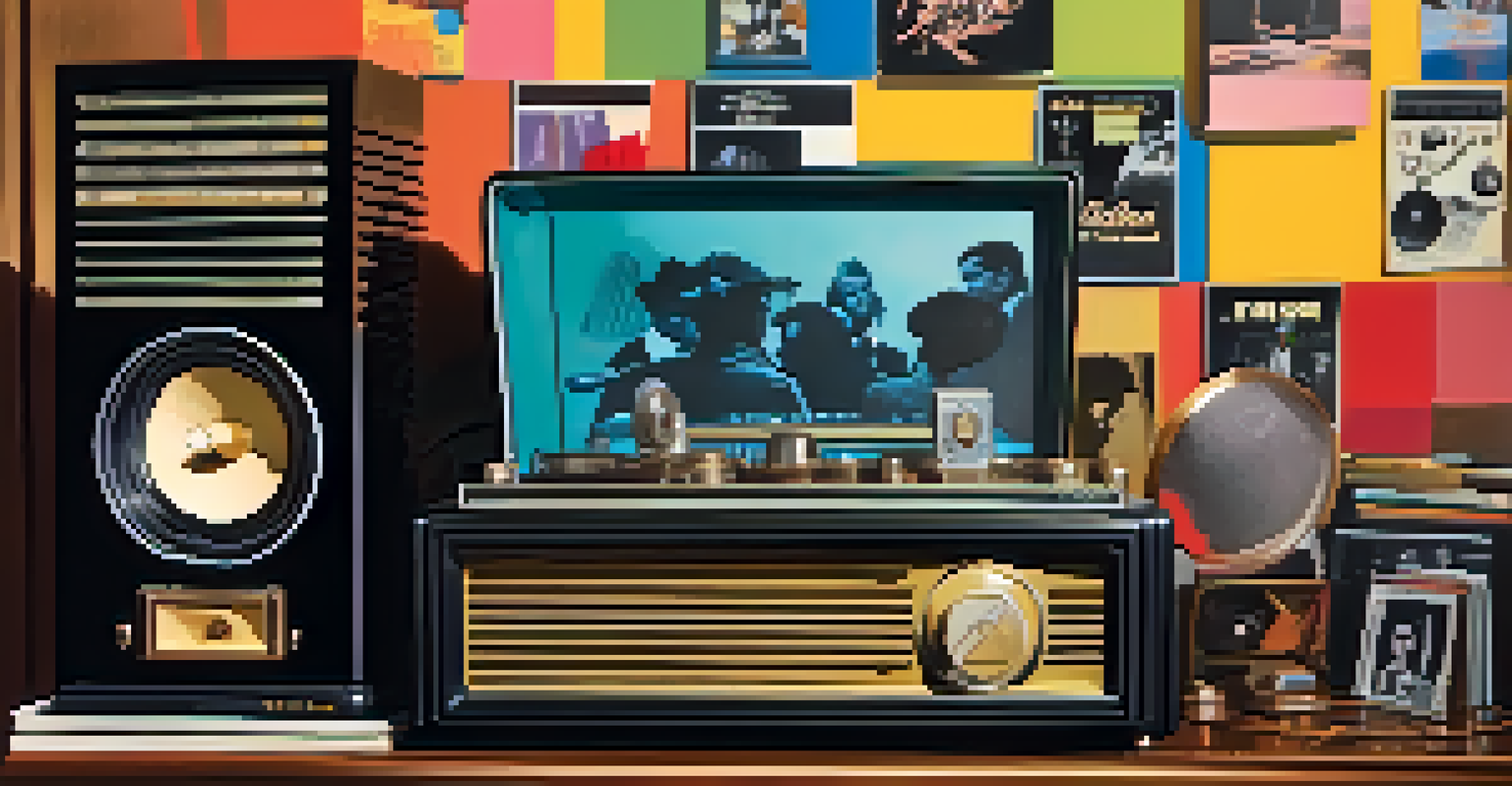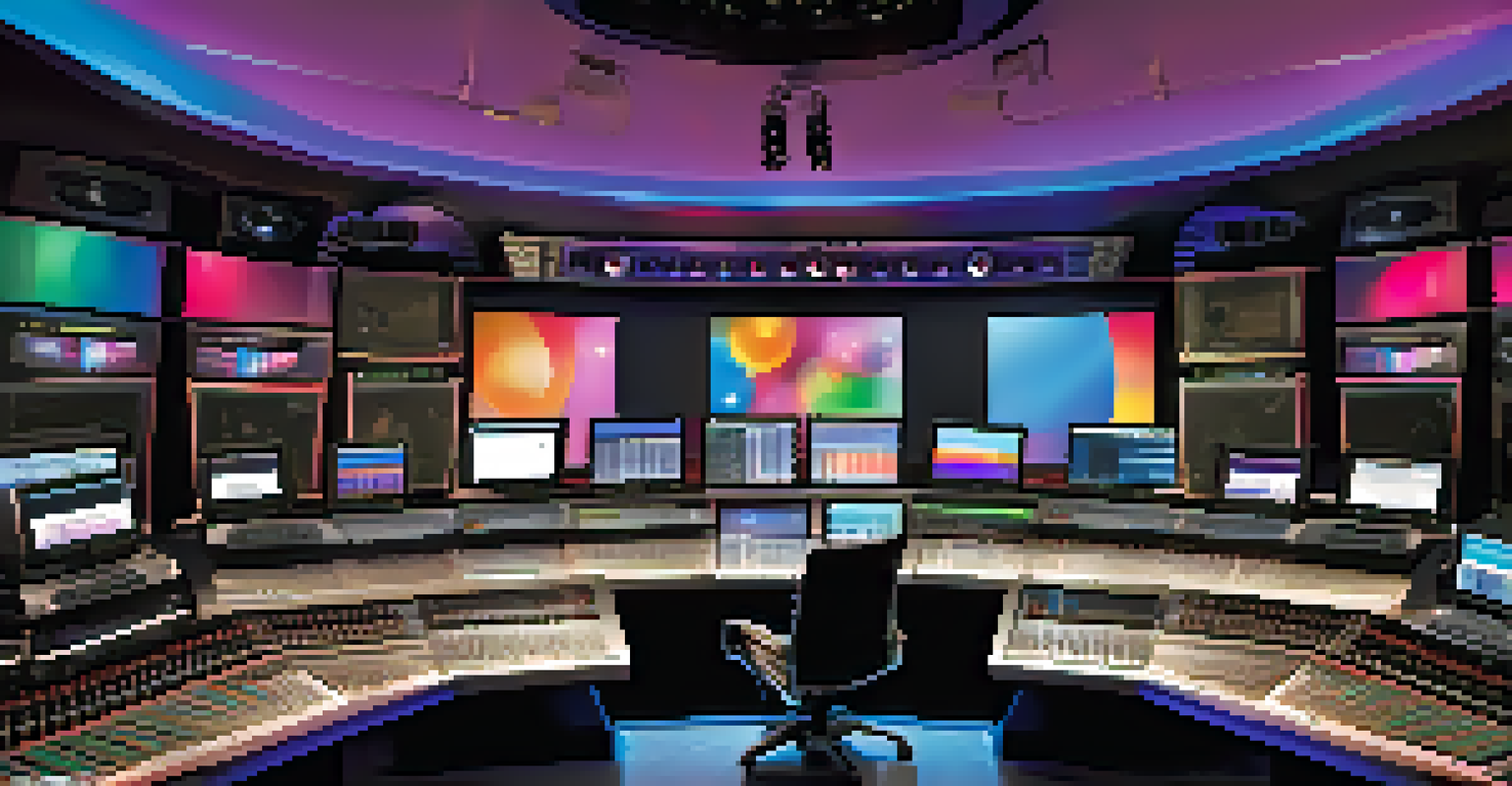The Influence of Radio: Music Dissemination Over Time

The Birth of Radio and Its Early Impact on Music
Radio emerged in the early 20th century as a groundbreaking technology that transformed communication. Initially, it served military and maritime purposes, but soon its potential for entertainment became apparent. This marked the beginning of music dissemination, as radio stations began broadcasting popular songs to the public, making music accessible to everyone, regardless of location.
Radio is the theater of the mind; television is the theater of the mindless.
The first radio broadcasts in the 1920s brought music into homes like never before. Families gathered around their radios, eagerly tuning in to hear the latest hits or live performances, creating a shared cultural experience. This new medium set the stage for artists and genres to gain widespread recognition, changing the music landscape forever.
As radio stations multiplied, so did the diversity of music they offered. From jazz to country, listeners could explore various genres, fostering a sense of community and shared interests. This era of radio laid the foundation for future music trends and established radio as a vital player in the music industry.
The Golden Age of Radio and Its Cultural Significance
The 1930s to 1950s are often referred to as the Golden Age of Radio, a time when the medium reached its zenith in popularity. Radio became the primary source of entertainment, and music programs attracted millions of listeners. Iconic shows like 'American Bandstand' not only showcased popular artists but also influenced musical tastes across the nation.

During this period, radio played a crucial role in shaping popular culture. It introduced new artists and genres, giving rise to household names such as Frank Sinatra and Ella Fitzgerald. The ability to hear music instantly and frequently helped create a collective cultural memory, as songs became the soundtrack of people's lives.
Radio's Evolution Through Decades
From its birth in the early 20th century to the digital age, radio has continually adapted to changing technologies and listener preferences.
Moreover, radio fostered a sense of unity during challenging times, such as the Great Depression and World War II. Music served as a source of comfort and hope, bringing people together and helping them cope with adversity. This emotional connection to music solidified radio's position as a cherished medium in American society.
The Transition to Television and Its Effects on Radio
As television gained popularity in the 1950s, radio faced new challenges. With a shift in entertainment preferences, many feared that radio would become obsolete. However, instead of disappearing, radio adapted by focusing on music and talk shows that television couldn't replicate, solidifying its niche.
The great thing about music is that it transcends language.
Radio's flexibility allowed it to thrive alongside television, introducing formats like Top 40 and FM broadcasting. These innovations catered to younger audiences and emphasized music, giving rise to the 'DJ' culture that remains influential today. Radio stations began to curate playlists, guiding listeners through the ever-expanding music landscape.
This era of adaptation also saw the emergence of niche radio stations, catering to specific genres and demographics. From rock to hip-hop, these stations created dedicated communities around music, proving that radio could coexist with television and continue to play a vital role in music dissemination.
The Rise of FM Radio and Its Impact on Music Variety
The introduction of FM radio in the 1960s marked a significant turning point for music broadcasting. With better sound quality and the ability to transmit a wider range of frequencies, FM stations quickly gained popularity. This technological advancement allowed for a richer listening experience, encouraging more diverse music selections.
FM radio stations began to experiment with programming, leading to the rise of album-oriented rock and progressive formats. This shift allowed listeners to hear entire albums rather than just singles, giving artists an opportunity to showcase their full artistic vision. It also created a platform for emerging genres, such as punk and disco, to reach broader audiences.
Cultural Impact of Radio
Radio has played a crucial role in shaping popular culture and music trends, creating shared experiences among listeners.
As FM radio flourished, it helped to democratize music consumption by promoting independent and lesser-known artists. Stations like WNEW in New York became known for supporting new talent, allowing listeners to discover fresh sounds. This commitment to variety not only enriched the music scene but also encouraged a culture of exploration among listeners.
The Advent of Digital Radio and Streaming Services
The transition to digital technology in the late 20th century brought about significant changes in radio broadcasting. Digital radio offered improved sound quality and the ability to transmit multiple channels over a single frequency. This innovation expanded the listening options available to audiences, paving the way for specialized programming tailored to unique tastes.
With the rise of the internet, streaming services began to emerge, further transforming how people accessed music. Platforms like Spotify and Pandora allowed users to create personalized playlists, making traditional radio feel less relevant. However, many radio stations adapted by developing their own streaming options, ensuring they remained a part of the digital landscape.
This shift also led to the resurgence of podcasting, a format that allows for in-depth discussions and storytelling. Radio stations began to produce podcasts, attracting a new generation of listeners who appreciate the flexibility of on-demand content. The evolution of radio in the digital age demonstrates its resilience and ability to innovate in response to changing consumer preferences.
The Role of Radio in Supporting Local Artists and Communities
Despite the challenges posed by digital media, radio continues to play a vital role in supporting local artists and communities. Many local stations focus on promoting regional talent, providing a platform for musicians who may not have the resources to reach wider audiences. This commitment fosters a sense of community and pride in local music scenes.
Radio's ability to connect with listeners on a personal level enhances its role in supporting local artists. DJ-hosted shows often provide insights into the stories behind the music, creating a deeper connection between the artist and the audience. This relationship helps build a loyal fan base for emerging talent, contributing to the growth of local music ecosystems.
Support for Local Artists
Despite digital competition, radio remains vital in promoting local talent and fostering community connections.
Moreover, radio stations often collaborate with local events, such as music festivals and concerts, to showcase talent. By partnering with community organizations, radio not only promotes local artists but also strengthens community bonds. This ongoing support illustrates radio's enduring significance in the music landscape.
The Future of Radio: Adapting to Changing Media Landscapes
As the media landscape continues to evolve, radio faces new challenges and opportunities. The rise of social media and mobile applications has changed how people discover and share music, prompting radio to rethink its strategies. However, these changes also present avenues for growth, particularly in audience engagement and content creation.
Many radio stations are now leveraging social media platforms to interact with listeners in real-time, enhancing their connection with audiences. By sharing live events, exclusive interviews, and behind-the-scenes content, radio is finding innovative ways to remain relevant in a fast-paced digital world. This adaptability will be crucial as consumer preferences continue to shift.

Furthermore, the integration of artificial intelligence and data analytics into radio programming allows for more personalized content delivery. By analyzing listener preferences, stations can create tailored music experiences that resonate with audiences. The future of radio lies in its ability to embrace technology while maintaining its core mission of music dissemination and community connection.